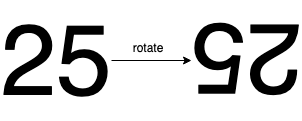A confusing number is a number that when rotated 180 degrees becomes a different number with each digit valid.
We can rotate digits of a number by 180 degrees to form new digits.
- When
0,1,6,8, and9are rotated180degrees, they become0,1,9,8, and6respectively. - When
2,3,4,5, and7are rotated180degrees, they become invalid.
Note that after rotating a number, we can ignore leading zeros.
- For example, after rotating
8000, we have0008which is considered as just8.
Given an integer n, return true if it is a confusing number, or false otherwise.
Example 1:
Input: n = 6 Output: true Explanation: We get 9 after rotating 6, 9 is a valid number, and 9 != 6.
Example 2:
Input: n = 89 Output: true Explanation: We get 68 after rotating 89, 86 is a valid number and 86 != 89.
Example 3:
Input: n = 11 Output: false Explanation: We get 11 after rotating 11, 11 is a valid number but the value remains the same, thus 11 is not a confusing number
Example 4:
Input: n = 25 Output: false Explanation: We get an invalid number after rotating 25.
Constraints:
0 <= n <= 109
Companies:
Google
Related Topics:
Math
Similar Questions:
// OJ: https://leetcode.com/problems/confusing-number/
// Author: github.com/lzl124631x
// Time: O(lgN)
// Space: O(1)
class Solution {
public:
bool confusingNumber(int n) {
int m[10] = {0,1,-1,-1,-1,-1,9,-1,8,6}, r = 0, num = n;
while (n) {
if (m[n % 10] == -1) return false;
r = r * 10 + m[n % 10];
n /= 10;
}
return num != r;
}
};


